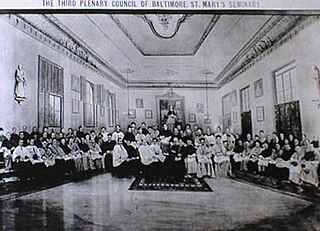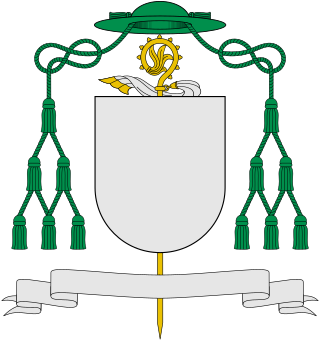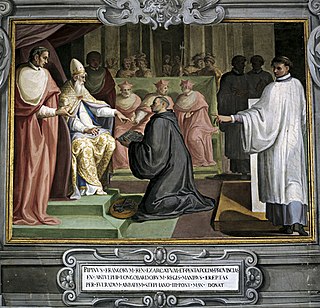Primate is a title or rank bestowed on some important archbishops in certain Christian churches. Depending on the particular tradition, it can denote either jurisdictional authority or (usually) ceremonial precedence.

A clergy house is the residence, or former residence, of one or more priests or ministers of religion. Residences of this type can have a variety of names, such as manse, parsonage, rectory or vicarage.

The Ruthenian Greek Catholic Church, also known as the Byzantine Catholic Church in the United States, is a sui iuris (autonomous) Eastern Catholic church based in Eastern Europe and North America. As a particular church of the Catholic Church, it is in full communion with the Holy See. It uses the Byzantine Rite for its liturgies, laws, and cultural identity.

Monsignor is a form of address or title for certain members of the clergy in the Catholic Church. Monsignor is the apocopic form of the Italian monsignore, meaning "my lord". "Monsignor" can be abbreviated as Mons. or Msgr. In some countries, the title "monsignor" is used as a form of address for bishops. However, in English-speaking countries, the title is unrelated to the episcopacy, though many priests with the title later become bishops.

The Plenary Councils of Baltimore were three meetings of American Catholic bishops, archbishops and superiors of religious orders in the United States. The councils were held in 1852, 1866 and 1884 in Baltimore, Maryland.

A territorial abbey is a particular church of the Catholic Church comprising defined territory which is not part of a diocese but surrounds an abbey or monastery whose abbot or superior functions as ordinary for all Catholics and parishes in the territory. Such an abbot is called a territorial abbot or abbot nullius diœceseos. A territorial abbot thus differs from an ordinary abbot, who exercises authority only within the monastery's walls or to monks or canons who have taken their vows there. A territorial abbot is equivalent to a diocesan bishop in Catholic canon law.
A Commissary Apostolic is Commissary who has been appointed by the pope, hence commissary Apostolic.
In the Catholic Church, fabrica ecclesiæ is a term meaning, etymologically, the construction of a church, but in a broader sense the funds necessary for such construction.

The Diocese of Galway, Kilmacduagh and Kilfenora is a Latin Church diocese of the Catholic Church in the west of Ireland. It is in the ecclesiastical province of Tuam and is subject to the Metropolitan Archdiocese of Tuam. The deanery of Kilfenora, previously a diocese in its own right, lies in the ecclesiastical province of Cashel. The ordinary is Bishop Michael Duignan who was appointed on 11 February 2022.
Trusteeism and the trustee system are practices and institutions within certain parishes of the Catholic Church in the United States, under which laypersons participate in the administration of Ecclesiastical Property. When laypersons are among the trustees, the Church seeks agreement with the civil authorities to have the property administered under principles of canon law.
In the canon law of the Roman Catholic Church, an administrator of ecclesiastical property is anyone charged with the care of church property.

Papal appointment was a medieval method of selecting the Pope. Popes have always been selected by a council of Church fathers, however, Papal selection before 1059 was often characterized by confirmation or nomination by secular European rulers or by the preceding pope. The later procedures of the Papal conclave are in large part designed to prohibit interference of secular rulers, which to some extent characterized the first millennium of the Roman Catholic Church, e. g. in practices such as the creation of crown-cardinals and the claimed but invalid jus exclusivae. Appointment may have taken several forms, with a variety of roles for the laity and civic leaders, Byzantine and Germanic emperors, and noble Roman families. The role of the election vis-a-vis the general population and the clergy was prone to vary considerably, with a nomination carrying weight that ranged from nearly determinative to merely suggestive, or as ratification of a concluded election.

The apostolic constitution Romanos Pontifices, by Pope Leo XIII, was issued 8 May 1881, and defined the relations in England and Scotland between bishops and members of religious institutes. This constitution was later extended to the United States, to Canada, to South America, to the Philippine Islands, and quite generally to missionary countries.
"Desservants" was the name of a class of French parish priests.
Precedence signifies the right to enjoy a prerogative of honor before other persons; for example, to have the most distinguished place in a procession, a ceremony, or an assembly, to have the right to express an opinion, cast a vote, or append a signature before others, to perform the most honorable offices.
John Edmund Fitzmaurice was an American prelate of the Roman Catholic Church who served as the fourth bishop of the Diocese of Erie in Pennsylvania (1899–1920).

From 756 to 857, the papacy shifted from the influence of the Byzantine Empire to that of the kings of the Franks. Pepin the Short, Charlemagne, and Louis the Pious had considerable influence in the selection and administration of popes. The "Donation of Pepin" (756) ratified a new period of papal rule in central Italy, which became known as the Papal States.
A rector is, in an ecclesiastical sense, a cleric who functions as an administrative leader in some Christian denominations. In contrast, a vicar is also a cleric but functions as an assistant and representative of an administrative leader.
Immaculate Heart of Mary Church, is a Catholic parish church in Cleveland, Ohio and part of the Diocese of Cleveland. It is a located on Lansing Ave. near East 66th St., in a part of the South Broadway neighborhood previously known as Warszawa, also referred to today as Slavic Village. Both the church and the area are GNIS named features. The church is in the neighborhood of, but not within, the area listed as Warszawa Neighborhood District on the National Register of Historic Places. The church, school, rectory, and convent buildings are listed together as a Cleveland Designated Landmark.
The Law of Guarantees, sometimes also called the Law of Papal Guarantees, was the name given to the law passed by the senate and chamber of the Parliament of the Kingdom of Italy, 13 May 1871, concerning the prerogatives of the Holy See, and the relations between state and church in the Kingdom of Italy. It guaranteed sovereign prerogatives to the pope, who had been deprived of the territory of the Papal States. The popes refused to accept the law, as it was enacted by a foreign government and could therefore be revoked at will, leaving the popes without a full claim to sovereign status. In response, the popes declared themselves prisoners of the Vatican. The ensuing Roman Question was not resolved until the Lateran Pacts of 1929.









